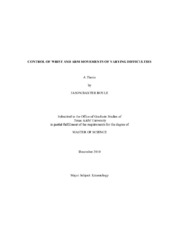| dc.description.abstract | Three experiments compared wrist and arm performance in a cyclical Fitts’ target task. The purpose of Experiment I was to determine if movement kinematics differed for wrist/elbow flexion/extension movements to targets of varying difficulty. Participants were asked to flex/extend a manipulandum in the horizontal plane at the wrist and elbow joint in an attempt to move back and forth between two targets. Online knowledge of effector position was displayed as a visual trace on a projector screen. Target widths were manipulated with amplitude constant (16 degrees) in order to create Indexes of Difficulty of 1.5, 3, 4.5, and 6. Results failed to detect differences in elbow and wrist movements either in terms of movement time, movement accuracy, or kinematic characteristics of the movement. In studies that have reported difference in wrist and arm performance in Fitts’ target tasks, experimenters have typically utilized visual amplification to counterbalance the small resulting wrist movements. The purpose of Experiments II and III was to investigate how changes in task parameters and visual gain play a role in providing a performance advantage for the wrist. In these experiments arm movement amplitude was increased to 32 degrees and wrist amplitude was decreased to 8 degrees. Results found similar overall movement times for arm and wrist movements. However, kinematic analysis of the movement revealed relatively large dwell times for wrist movements at IDs of 4.5 and 6. Removal of dwell time resulted in faster movement times for the wrist compared to arm. The results of these three experiments add to the limited literature examining how different effectors perform a Fitts’ target task. These findings suggest that performance differences in past literature may be due to the visual amplification often used when arm, wrist, and finger movements are studied. | en |


